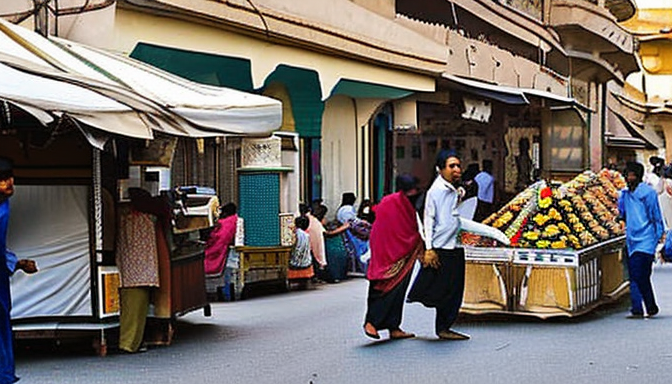Karachi, a city teeming with life, holds stories in its walls. The colonial era left a mark that is both beautiful and complex. Imagine wandering through streets where British architecture meets local flair. Each building tells a story, a whisper of the past that still echoes today.
When you stroll down Mohatta Palace or gaze at the grandeur of the Frere Hall, you can almost feel the British influence wrapping around you like a warm blanket. These structures are not just buildings; they are pieces of history. They reflect a time when Karachi was a bustling port city, a hub of trade and culture. The blend of Gothic and Indo-Saracenic styles creates a unique skyline that stands out. It’s like a tapestry woven with threads of different cultures.
But what about the policies that shaped this city? The British brought changes that affected everything from governance to urban planning. They introduced systems that, while often oppressive, also laid the groundwork for modern Karachi. The roads we travel today, the parks we enjoy, all have roots in this era.
So, why should we care? Understanding Karachi’s colonial past helps us appreciate its present. It’s a reminder of how history shapes identity. As we explore these colonial secrets, we uncover not just the city’s past, but also its future. Are you ready to dive deeper into Karachi’s rich tapestry?
Architectural Marvels of the Colonial Era
Karachi is a city that tells a story through its buildings. The colonial era left a mark that is hard to miss. As you stroll through the streets, you can see how British architecture intertwined with local styles. It’s like a dance of cultures, each step revealing something new.
Take a moment to look up. The skyline is dotted with stunning structures that echo the past. Buildings like the Frere Hall and the Mohatta Palace stand as proud reminders of a time when Karachi was a bustling hub for British officials and traders. Each brick tells a tale, a whisper of the policies and decisions that shaped the city.
What’s fascinating is how these colonial designs were not just about aesthetics. They were practical too. The grand arches and high ceilings were built to combat the heat, making them both beautiful and functional. The blend of Gothic and Mughal styles created a unique architectural language that still speaks to us today.
As you explore, consider how these buildings have influenced modern Karachi. They are not just relics; they are part of the city’s identity. The legacy of the colonial era is alive in the way people live, work, and interact with their environment. Karachi’s past is not just history; it’s a living, breathing part of its present.

Cultural Influences and Legacy
Karachi’s colonial past is like a fascinating storybook, filled with chapters of change and adaptation. When the British arrived, they didn’t just bring their governance; they also introduced a blend of culture that would leave a lasting mark on the city. Think of it as a melting pot where British traditions mixed with local customs, creating a unique identity. For instance, the food scene in Karachi is a perfect example of this fusion. You can enjoy spicy biryani alongside fish and chips, a delicious reminder of the city’s diverse heritage.
The architecture in Karachi tells its own tale. Buildings like the Frere Hall and the Mohatta Palace showcase a stunning mix of Gothic and Mughal designs. They stand tall, whispering stories of the past. Just imagine walking through these grand structures, feeling the history seep into your bones. It’s not just about the bricks and mortar; it’s about the lives that were lived within those walls.
Moreover, the impact of colonial policies shaped the city’s urban landscape. The introduction of railways and schools changed how people lived and interacted. This led to a more connected community, paving the way for the vibrant city we see today. Even the language spoken here is a testament to this legacy. English, Urdu, and Sindhi coexist, reflecting the city’s rich tapestry.
In essence, Karachi’s colonial influences are not just remnants of the past; they are the threads that weave together its present and future. Exploring these cultural layers gives us a deeper appreciation for the city and its people.
Frequently Asked Questions
- What are some key architectural features of Karachi’s colonial buildings?
Karachi’s colonial buildings often showcase a fascinating mix of British and local styles. Look for elements like arched windows, intricate facades, and spacious verandas that reflect the grandeur of the era. These structures not only tell a story but also serve as a canvas of cultural fusion.
- How has colonial history influenced Karachi’s culture today?
The impact of colonial rule is evident in Karachi’s diverse cuisine, language, and social customs. The blending of British and local traditions has given rise to unique dishes and a rich tapestry of languages spoken in the city. It’s like a cultural melting pot that continues to evolve!
- Are there any tours available to explore Karachi’s colonial heritage?
Absolutely! There are several guided tours that focus on Karachi’s colonial history. These tours often include visits to iconic buildings, museums, and neighborhoods that highlight the city’s past. It’s a great way to immerse yourself in the stories that shaped Karachi.
- What is the best time to visit Karachi for a historical tour?
The ideal time to explore Karachi is during the winter months from November to February. The weather is pleasant, making it perfect for walking tours. Plus, you’ll be able to enjoy the city’s vibrant atmosphere without the scorching heat!